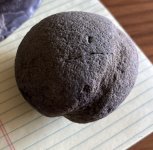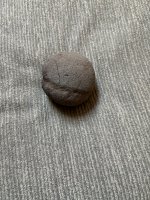Found this along a riverbed. Is it some sort of hammerhead or all natural? Thank you.
Navigation
Install the app
How to install the app on iOS
Follow along with the video below to see how to install our site as a web app on your home screen.
Note: This feature may not be available in some browsers.
More options
You are using an out of date browser. It may not display this or other websites correctly.
You should upgrade or use an alternative browser.
You should upgrade or use an alternative browser.
🔎 UNIDENTIFIED First post! What is this?
- Thread starter RoyBatty
- Start date
DizzyDigger
Gold Member
- Dec 9, 2012
- 6,071
- 12,168
- Detector(s) used
- Nokta FoRs Gold, a Gold Cube, 2 Keene Sluices and Lord only knows how many pans....not to mention a load of other gear my wife still doesn't know about!
- Primary Interest:
- Prospecting
Welcome Roy.. 
Not sure about that rock...almost looks like it could have a band of softer material that weathered away (natural), or it could have been done by man in an effort to mount it on a stick.
I'm no expert in any sense when it comes to rocks, so let's wait til someone who knows what they're talking about chimes in.

Not sure about that rock...almost looks like it could have a band of softer material that weathered away (natural), or it could have been done by man in an effort to mount it on a stick.
I'm no expert in any sense when it comes to rocks, so let's wait til someone who knows what they're talking about chimes in.
Upvote
1
- Thread starter
- #3
Thank you. It's sandstone so i can't imagine it would be used for day to day use. Maybe for fighting or hunting if anything?Welcome Roy..
Not sure about that rock...almost looks like it could have a band of softer material that weathered away (natural), or it could have been done by man in an effort to mount it on a stick.
I'm no expert in any sense when it comes to rocks, so let's wait til someone who knows what they're talking about chimes in.
Upvote
0
- Jul 27, 2006
- 48,895
- 56,130
- Detector(s) used
- Minelab_Equinox_ 800 Minelab_CTX-3030 Minelab_Excal_1000 Minelab_Sovereign_GT Minelab_Safari Minelab_ETrac Whites_Beach_Hunter_ID Fisher_1235_X
- Primary Interest:
- All Treasure Hunting
Stone. Looks natural, groove does not looked formed by flaking, pecking or made from abrasion. Looks like a softer stone wore away.
Upvote
1
- Thread starter
- #10
Hello, I found it along the Cuyahoga River in NE Ohio. Thank you for the information.Hi RoyBatty,
Welcome to the "Show"!
The shape appears to be what you said...A Hammer Stone.
We did you find it...Possible dating!
View attachment 2133708View attachment 2133709View attachment 2133710
Upvote
1
Robot
Bronze Member
- Mar 10, 2014
- 2,038
- 1,736
- Primary Interest:
- Other
I would believe your artifact was made by the now named Whittlesey Native American people between 1000 to 1640 AD
Whittlesey culture is an archaeological designation for a Native American people, who lived in northeastern Ohio during the Late Precontact and Early Contact period between A.D. 1000 to 1640. By 1500, they flourished as an agrarian society that grew maize, beans, and squash. After European contact, their population decreased due to disease, malnutrition, and warfare. There was a period of long, cold winters that would have impacted their success cultivating food from about 1500.
The Whittlesey culture people created a distinctive style of pottery and built defensive villages, set high on promontories with steep cliffs and surrounded by ditches or stockades. Their villages were on the Lake Erie plain or overlooking rivers and streams. About 1640, Whittlesey villages were abandoned and due to the displacement of Native groups during the early contact period with Europeans, it is not known where or how they relocated.
South Park Village, a Whittlesey culture site in Cuyahoga County, is listed on the National Register of Historic Places. A historic marker about the Whittlesey people is located on Seeley Road in LeRoy Township, Lake County, Ohio
Whittlesey culture is an archaeological designation for a Native American people, who lived in northeastern Ohio during the Late Precontact and Early Contact period between A.D. 1000 to 1640. By 1500, they flourished as an agrarian society that grew maize, beans, and squash. After European contact, their population decreased due to disease, malnutrition, and warfare. There was a period of long, cold winters that would have impacted their success cultivating food from about 1500.
The Whittlesey culture people created a distinctive style of pottery and built defensive villages, set high on promontories with steep cliffs and surrounded by ditches or stockades. Their villages were on the Lake Erie plain or overlooking rivers and streams. About 1640, Whittlesey villages were abandoned and due to the displacement of Native groups during the early contact period with Europeans, it is not known where or how they relocated.
South Park Village, a Whittlesey culture site in Cuyahoga County, is listed on the National Register of Historic Places. A historic marker about the Whittlesey people is located on Seeley Road in LeRoy Township, Lake County, Ohio
Upvote
1
- Thread starter
- #12
Great information. I appreciate you taking the time to inform me. Thank you!I would believe your artifact was made by the now named Whittlesey Native American people between 1000 to 1640 AD
Whittlesey culture is an archaeological designation for a Native American people, who lived in northeastern Ohio during the Late Precontact and Early Contact period between A.D. 1000 to 1640. By 1500, they flourished as an agrarian society that grew maize, beans, and squash. After European contact, their population decreased due to disease, malnutrition, and warfare. There was a period of long, cold winters that would have impacted their success cultivating food from about 1500.
The Whittlesey culture people created a distinctive style of pottery and built defensive villages, set high on promontories with steep cliffs and surrounded by ditches or stockades. Their villages were on the Lake Erie plain or overlooking rivers and streams. About 1640, Whittlesey villages were abandoned and due to the displacement of Native groups during the early contact period with Europeans, it is not known where or how they relocated.
South Park Village, a Whittlesey culture site in Cuyahoga County, is listed on the National Register of Historic Places. A historic marker about the Whittlesey people is located on Seeley Road in LeRoy Township, Lake County, Ohio
Upvote
0
Top Member Reactions
-
 2501
2501 -
 1642
1642 -
 1381
1381 -
 1373
1373 -
 1246
1246 -
 976
976 -
 934
934 -
 858
858 -
 848
848 -
 823
823 -
 764
764 -
 730
730 -
 623
623 -
 479
479 -
 437
437 -
E
399
-
 376
376 -
 333
333 -
 311
311 -
 309
309
Users who are viewing this thread
Total: 2 (members: 0, guests: 2)









